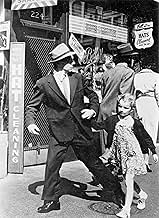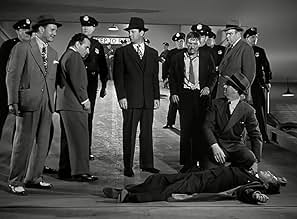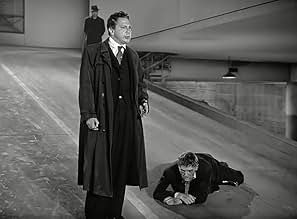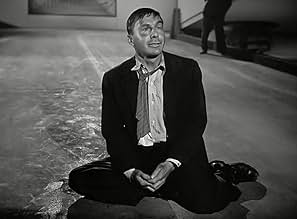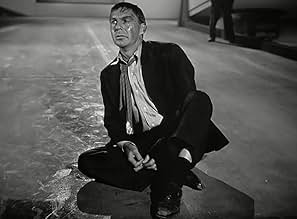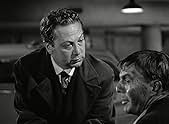1931 के जर्मन थ्रिलर के इस अमेरिकीकरण में, पुलिस और अपराधी दोनों अंडरवर्ल्ड के एक रहस्यमय हत्यारे को मारते हैं जो छोटे बच्चों की शिकार करता है.1931 के जर्मन थ्रिलर के इस अमेरिकीकरण में, पुलिस और अपराधी दोनों अंडरवर्ल्ड के एक रहस्यमय हत्यारे को मारते हैं जो छोटे बच्चों की शिकार करता है.1931 के जर्मन थ्रिलर के इस अमेरिकीकरण में, पुलिस और अपराधी दोनों अंडरवर्ल्ड के एक रहस्यमय हत्यारे को मारते हैं जो छोटे बच्चों की शिकार करता है.
- Lemke
- (as Lennie Bremen)
फ़ीचर्ड समीक्षाएं
The remake is well made, but mostly because of Wayne's basically non-verbal performance and the fact that producer Seymour Nebenzal was only allowed to make it if it almost exactly mirrored the original. That was due to Production Code concern that the movie not include child molestation as part of the plot. In fact, before he hired director Joseph Losey, he asked fellow German ex-pat Douglas Sirk to direct, but Sirk turned the project down because he wanted to do a rewrite. (Losey also wanted to rewrite it, but for the same reasons, couldn't.)
You see the same camera work, the child is approached by a man at a candy machine, but he is only seen in the mirror and from the legs down (very menacing); the killer buys balloons for the girls he kills to pacify them and the balloon is seen floating above the power lines once the child has been killed; a child's ball that she was bouncing a moment before her death comes rolling into the frame and we know, again, a child has been killed.
The kangaroo court held by the mobsters is almost identical to the original as is the search for the killer in a giant commercial building. The motives are the same; the mob wants to get the child killer because he offends even their criminal senses and because they want good publicity from the police, press and public.
There is one very American element to the remake, however, and that's the use of psychotherapy/psychology that was sweeping the nation around this time (and which continues today). Wayne gives a speech explaining his domineering mother's hatred toward the "evil of men, just men" and his need to be punished not only for his deeds but because he is, simply that, a man.
I thought I would hate this remake but I didn't. Although not as startling and striking as the original, there is still a place for this remake I think in the catalog of American cinema. There are very good character actors as well, including Raymond Burr as a gravel-voiced mob enforcer, Howard Da Silva as a chain-smoking homicide detective, Martin Gabel as the crime boss trying to get all the mileage he can out of catching the killer and Luther Adler as an alcoholic criminal attorney who puts up a defense for Wayne and maybe himself simultaneously.
There is also the cinematography of '50s Los Angeles by Ernest Laszlo that serves as another character in the film--it appears to have been filmed on location and it is eye-opening to see this portrait of the City of Angels. Not looking very angelic.
I would have to say I liked this "M" but it is not as good as the original; maybe it isn't trying to be. Like their German roots, the film and the filmmakers seem to be searching for something uniquely American.
The movie has many fine touches, except for the final chase whose massive gangland presence without police intervention amounts to a real stretch. Where the film excels is with Harrow alone and acting out his illness. Note how he squeezes off the head of a female doll with a photo of his mother in the background, the significance of which turns up at the end. Also, his caressing of shoelaces from his victims suggests a sexual fetish. As a reader of true crime, I've learned that shoe fetishes are not that unusual-- there seems no end to human oddities. At the same time, there's the telling touch of a little girl's balloon soaring toward the heavens that implies her death at the killer's hands, along with a note of hope for something better. Oddly, actor Wayne has practically no lines until the final segment. There his monstrous nature is somewhat mitigated by a heartfelt recognition of his mother's twisted role that he was apparently too weak to overcome.
Ace director Losey makes good use of the many LA locations including the famous Bradbury building from DOA (1950) among others. And that's along with a number of noirish lighting touches. Too bad Hollywood's notorious Blacklist period sent him into exile in England during probably his most productive period.
Except for Wayne, the supporting cast is not called upon to express much emotion. Thus attention remains on the killer and the little girls he inveigles with toys and goodies. As indicated earlier, the weakest parts are the staging of the gangland mobs that appear to have buried their differences in favor of large uncontested mob action.
Despite the downside, the movie's subject matter challenged taboos of the time and still manages moments of genuine involvement.
Thanks to Losey 's talent ,the Americanization of "M" was a success. Please do not redo now!
Was it the growing Blacklist that resulted in this movie having no writing credits on screen? Perhaps, but also perhaps not, as the soon-to-be-blacklisted Howard da Silva and Joseph Losey both use their own names.
Losey and his team make excellent use of numerous Los Angeles locations, including Angel's Flight, Bunker Hill, the Bradbury Building (which is identified by name and location) and what seems to be that old amusement park in Long Beach, although what's seen here could be Venice.
David Wayne is fine as the disturbed child killer, and delivers the required final act speech very well. But he doesn't have the power and poetry of Lorre's performance--but then who in Hollywood in 1951 would have? The movie still has some of the comedy of Lang's original, but it's not as dry and sardonic, and there isn't as much of it. The score isn't good, and shoves the movie even more firmly in the direction of the melodrama it keeps threatening to become.
The very last shot is oddly theatrical in a literal sense: it looks like it is being performed on a stage. And I'm not sure what the point of the drunken lawyer trying to grasp a bit of his former glory really was. However, this element merely weakens the film, it doesn't destroy it.
No, this isn't as good as Lang's original, but Lang's original is perhaps the best film of a great director. It's a classic in almost every regard. This version of "M" is an interesting and largely successful attempt at adapting the themes and ideas of the original to Los Angeles, and to 1950s Hollywood. Naturally there are some weaknesses, but the movie is brisk and engrossing, and certainly doesn't deserve the obscurity into which it has fallen.
Some condemn the film merely for being a remake, but remakes have always been a large part of movie history. There's little reason to object to them, especially now that the original films tend to be available on video. (In the 1930s-50s, originals were generally withdrawn.) If the remake is good, then hooray, there are now two good movies on the subject. If it's bad, then the remake will soon be forgotten.
क्या आपको पता है
- ट्रिवियाBefore signing Joseph Losey as director, producer Seymour Nebenzal approached fellow German expatriate Douglas Sirk and offered him the job. Sirk said he would do the film only if he could scrap the original story and write a new one about a psychopathic murderer of children. When Nebenzal approached Losey, he also wanted to scrap the original story and do a new one about a child murderer, and Nebenzal told him that the Production Code Administration (PCA) had agreed to allow him to make the film only if the original story and script were kept. The PCA had approved "M" as a remake of an acknowledged classic, but if the story were changed, its approval would be withdrawn.
- गूफ़When the killer and the little girl are locked in the room, the large shadow of the microphone boom is clearly visible on the wall on the left side of the screen after she sits down on the floor.
- भाव
Police Chief Regan: To prevent other crimes, your police department has prepared five don'ts. DON'T let your children accept rides from strangers, sometimes these are one-way rides leading to death. The amiable stranger may be a killer. DON'T let your children accept presents from strangers. A bag of popcorn or a candy bar is not worth your child's life. DON'T send children on after-dark errands, the night works in behalf of the killer who preys on our young. If you must have something from the store after sundown, get it yourself. DON'T let your child play unattended in wooded places or empty lots. Though your eyes aren't on them, somebody else's may be watching. DON'T let your children become friendly with Pop, that nice old character in your neighborhood. Most of these men are harmless, but there are exceptions. It's up to you to make sure your child isn't the victim of one of these exceptions. And now for one all important do: If you notice any suspicious characters lurking around schools and playgrounds, DO call at once, your police department: Central 5000, the life you save may be your child's life.
- कनेक्शनFeatured in The 3 Faces of M (2022)
टॉप पसंद
विवरण
- रिलीज़ की तारीख़
- कंट्री ऑफ़ ओरिजिन
- भाषा
- इस रूप में भी जाना जाता है
- El maldito
- फ़िल्माने की जगहें
- Bradbury Building - 304 S. Broadway, Downtown, लॉस एंजेल्स, कैलिफोर्निया, संयुक्त राज्य अमेरिका(building where Harrow is trapped)
- उत्पादन कंपनी
- IMDbPro पर और कंपनी क्रेडिट देखें
- चलने की अवधि1 घंटा 28 मिनट
- रंग
- पक्ष अनुपात
- 1.37 : 1

